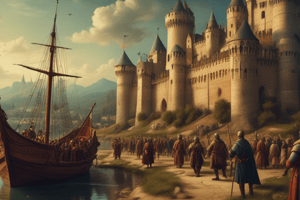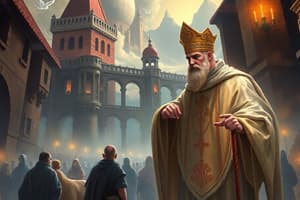Podcast
Questions and Answers
¿Cuál fue un factor que contribuyó al declive del Imperio Romano Occidental?
¿Cuál fue un factor que contribuyó al declive del Imperio Romano Occidental?
- Gasto militar excesivo (correct)
- Alianzas con otros imperios
- Estabilidad económica
- Corrupción en el ejército
¿Qué sistema de tenencia de tierras surgió durante la Edad Media?
¿Qué sistema de tenencia de tierras surgió durante la Edad Media?
- Comunismo
- Socialismo
- Capitalismo
- Feudalismo (correct)
¿Quién ocupaba el nivel más alto de la jerarquía feudal durante la Edad Media?
¿Quién ocupaba el nivel más alto de la jerarquía feudal durante la Edad Media?
- El clero
- El rey (correct)
- Los comerciantes
- Los caballeros
¿Qué surgió como consecuencia del vacío de poder tras la caída del Imperio Romano Occidental?
¿Qué surgió como consecuencia del vacío de poder tras la caída del Imperio Romano Occidental?
¿Qué caracterizó a la sociedad feudal durante la Edad Media?
¿Qué caracterizó a la sociedad feudal durante la Edad Media?
¿Qué comenzó a emerger durante la Edad Media consolidando el poder y estableciendo cortes reales y administraciones?
¿Qué comenzó a emerger durante la Edad Media consolidando el poder y estableciendo cortes reales y administraciones?
¿Cuál de las siguientes afirmaciones sobre la monarquía medieval es correcta?
¿Cuál de las siguientes afirmaciones sobre la monarquía medieval es correcta?
¿Cuál fue el principal objetivo de las Cruzadas?
¿Cuál fue el principal objetivo de las Cruzadas?
¿Cómo influyeron las Cruzadas en Europa?
¿Cómo influyeron las Cruzadas en Europa?
¿Cuál de las siguientes afirmaciones describe correctamente el poder de la Iglesia Católica en la Edad Media?
¿Cuál de las siguientes afirmaciones describe correctamente el poder de la Iglesia Católica en la Edad Media?
¿Cómo se estructuraba la sociedad medieval?
¿Cómo se estructuraba la sociedad medieval?
¿Qué importancia tienen los estudios comparativos en la comprensión de la historia medieval?
¿Qué importancia tienen los estudios comparativos en la comprensión de la historia medieval?
Flashcards are hidden until you start studying
Study Notes
Medieval History
Introduction
Medieval history refers to the period between the fall of the Western Roman Empire in 476 CE and the beginning of the Renaissance around 1400 CE. This era saw several significant changes in Europe, including the decline of the Roman Empire, the rise of feudalism, the emergence of powerful monarchies, and the development of the High and Late Middle Ages. In this article, we will delve into the key aspects of medieval history, providing a comprehensive overview of the political, social, religious, and cultural shifts that characterized this period.
Decline of the Roman Empire
The fall of the Western Roman Empire marked the end of antiquity and the beginning of the Middle Ages. Factors contributing to Rome's decline included military overspending, economic instability, government corruption, and external invasions. This collapse created a power vacuum that led to the fragmentation of the Roman territories into numerous small kingdoms, setting the stage for the emergence of feudalism.
Feudalism and the Emergence of Monarchies
Feudalism was a system of land tenancy in which nobles granted land to vassals in exchange for military service. This arrangement evolved into a hierarchical society characterized by mutual obligations, with the king at the top, followed by the nobility, knights, clergy, merchants, and peasantry. Over time, powerful monarchies began to emerge, consolidating power and establishing royal courts and administrations.
Role of Monarchy in Medieval Europe
Monarchs played a critical role in medieval societies, exerting influence over political, religious, and cultural aspects of life. They maintained and expanded territories through warfare, diplomacy, and dynastic marriages. Additionally, they appointed bishops and abbots, influenced Church policies, and patronized scholars and artists. This period saw the rise of strong central governments, laying the groundwork for modern nation-states.
Crusades and Religious Endeavors
The Crusades were a series of military campaigns sanctioned by the Catholic Church to recover the Holy Land from Muslim rule. Initiated by Pope Urban II in 1095, these expeditions brought together European armies under papal leadership, contributing to the spread of Christianity and the expansion of European influence abroad. Moreover, the Crusades fostered economic growth, as trade routes opened up, and influenced chivalric customs and literature.
Political History - Papal Power and the Medieval Church-State Relationship
The Roman Catholic Church held immense power during the Middle Ages, shaping religious practices, moral values, and public discourse. Popes often interfered in secular affairs, curtailing royal authority. However, as secular rulers grew stronger, the Church adapted, increasingly focusing on spiritual matters and refining its hierarchy. By the High Middle Ages, the Church was divided into regional provinces controlled by archbishops and bishops, who reported to the pope.
Social History
Life in the Middle Ages was defined by the rigid social structure, with individuals occupying distinct positions based on birth, wealth, and occupation. At the bottom of this hierarchy were the serfs, bound to the land and subject to the whims of their noble lords. Despite these harsh conditions, communities thrived, developing traditions and institutions that shaped the region's character.
Comparative Studies
Comparative studies allow researchers to analyze similarities, differences, and patterns across various regions and cultures within medieval history. By exploring themes like feudalism, chivalry, and religious practices in different parts of Europe, students can gain a broader perspective on the Middle Ages.
Influence on Modern Society
Many features of contemporary Western culture and politics trace back to the Middle Ages. The concept of the nation-state, constitutional law, legal concepts like habeas corpus, and democratic representation originated during this period. Furthermore, the arts and architecture of the Middle Ages laid the foundation for those enjoyed today.
In conclusion, the study of medieval history offers valuable insights into the formation of modern European societies. It is a period marked by dramatic changes, conflict, and creativity, ultimately shaping the world we inhabit today.
Studying That Suits You
Use AI to generate personalized quizzes and flashcards to suit your learning preferences.




